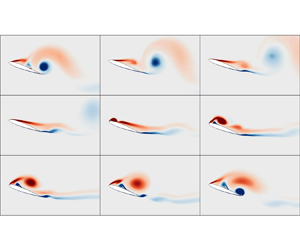Article contents
Geometric-control formulation and averaging analysis of the unsteady aerodynamics of a wing with oscillatory controls
Published online by Cambridge University Press: 12 October 2021
Abstract

Differential-geometric-control theory represents a mathematically elegant combination of differential geometry and control theory. Practically, it allows exploitation of nonlinear interactions between various inputs for the generation of forces in non-intuitive directions. Since its early developments in the 1970s, the geometric-control theory has not been duly exploited in the area of fluid mechanics. In this paper, we show the potential of geometric-control theory in the analysis of fluid flows, exemplifying it as a heuristic analysis tool for discovery of symmetry-breaking and unconventional force-generation mechanisms. In particular, we formulate the wing unsteady aerodynamics problem in a geometric-control framework. To achieve this goal, we develop a reduced-order model for the unsteady flow over a pitching–plunging wing that is (i) rich enough to capture the main physical aspects (e.g. nonlinearity of the flow dynamics at large angles of attack and high frequencies) and (ii) efficient and compact enough to be amenable to the analytic tools of geometric nonlinear control theory. We then combine tools from geometric-control theory and averaging to analyse the developed reduced-order dynamical model, which reveals regimes for lift and thrust enhancement mechanisms. The unsteady Reynolds-averaged Navier–Stokes equations are simulated to validate the theoretical findings and scrutinize the underlying physics behind these enhancement mechanisms.
- Type
- JFM Papers
- Information
- Copyright
- © The Author(s), 2021. Published by Cambridge University Press
References
REFERENCES
Taha et al. Supplementary Movie 1
Vorticity contours over the plunging cycle around mean angle of attack of 15◦, with reduced frequency k = 0.5 and plunging amplitude of 5◦ effective angle of attack. This low-amplitude, high-frequency plunging around the stall point (negative curvature of the steady lift curve) of NACA 0012 does not trigger a considerable leading edge vortex. A decrease in the mean lift coefficient is observed.
Taha et al. Supplementary Movie 2
Vorticity contours over the plunging cycle around mean angle of attack of 20◦, with reduced frequency k = 0.5 and plunging amplitude of 5◦ effective angle of attack. This low-amplitude, high-frequency plunging in the post-stall regime (positive curvature of the steady lift curve) of NACA 0012 triggers a considerable leading edge vortex, which leads to enhancement in the mean lift coefficient beyond the steady value.
- 7
- Cited by





